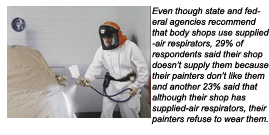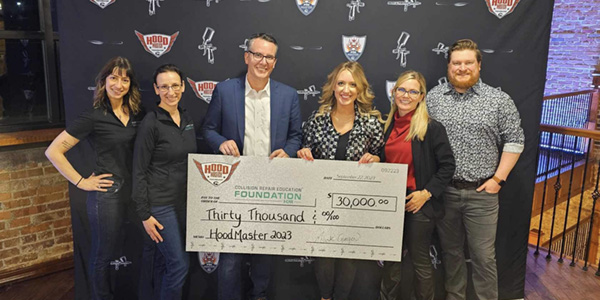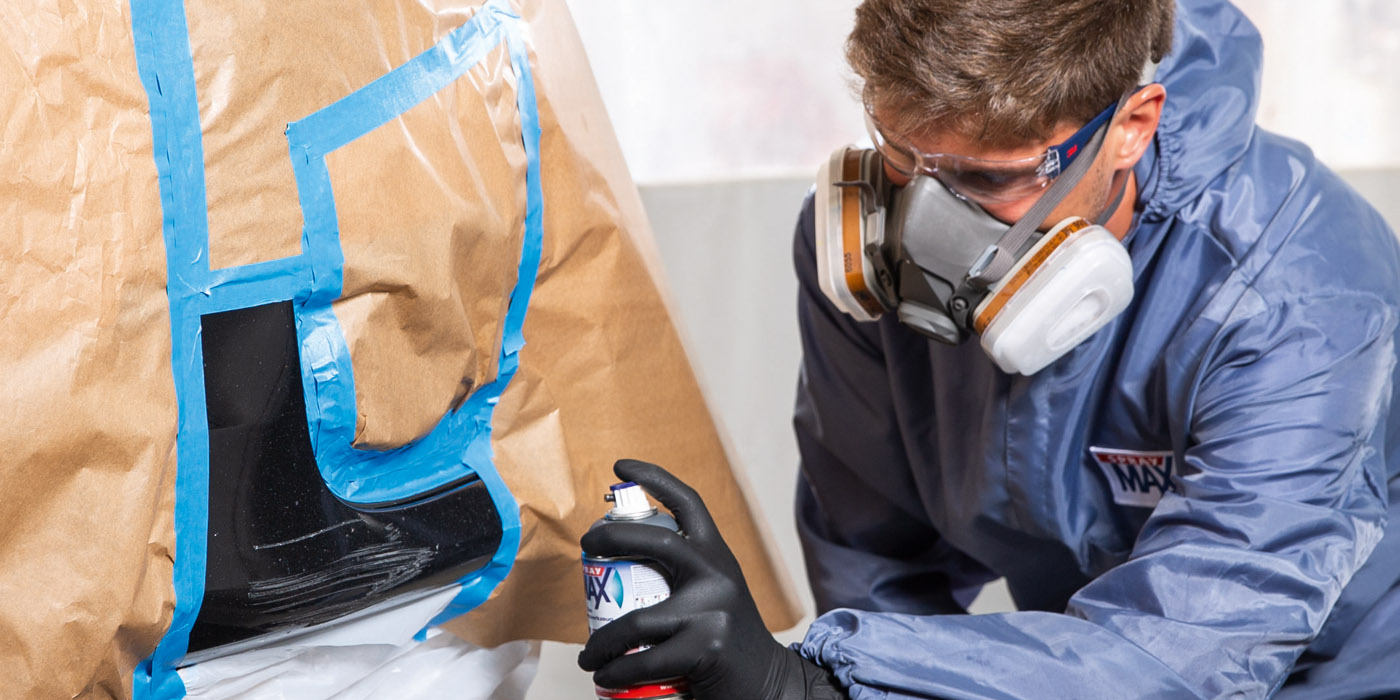
You’ve likely heard the term, “isocyanates,” but why should you care about them? Because:
- Isocyanates are present in the hardener or catalyst of polyurethane-based two-part paints.
- Isocyanates are toxic and reactive chemicals.
- Isocyanates can enter your body when you breathe them in or get them on your skin.
- Isocyanates can cause allergic reactions and increase your immune system’s sensitivity (i.e., you’ll react to much lower concentrations if you become “sensitized”).
- Isocyanates are a leading cause of work-related asthma.
- Isocyanates may pass right through latex gloves and contact your skin.
In Washington State, the Department of Labor and Industries and we at its Safety & Health & Assessment & Research for Prevention (SHARP) Program have been interested in isocyanates ever since we discovered that workers in the spray-on truck bed lining industry are at risk for developing work-related asthma. Although the coatings they use are different, both liner applicators and painters apply two-part polyurethane products using a spray gun. And both of these processes use isocyanates as hardeners. In spray-on truck bed linings, the hardener is mostly MDI (methyl diphenyl diisocyanate); in automotive paints, the hardener is typically based on HDI (hexamethylene diisocyanate).
Polyurethanes are some of the most useful coatings available, and there’s often no substitute for them. However, it’s important to realize that the isocyanate components of polyurethanes can cause severe health problems like asthma if they’re not handled correctly.
Work-related asthma must be diagnosed and treated early or it can become a lifelong illness. Practically every collision repair veteran knows someone who has either become “sensitized” or has developed asthma and left the industry. This is tragic for skilled workers who have trained as painters and worked as painters their entire life – only to be forced to find another career because painting makes them sick.
How did we learn about safety and health practices in collision repair? In May-June, we contacted several leading shop owners in Washington State and asked to visit their shops. Seven shop owners allowed us to tour their facilities in order to learn about best practices in health and safety. We also interviewed additional shop owners and others with experience in the collision repair industry.
In July, we mailed a survey to every collision repair shop that we could identify in Washington State. Almost 500 shops responded to our survey, thanks to the help and support of our partners in the industry, which included individual shop owners, the Automotive Service Association of Washington (ASA-WA) and the Autobody Craftsman Association (ACA). The response rate was 70%, which is extremely good for a survey of small businesses.
What Did We Learn?
A great deal. Although the study involved only collision repair shops in Washington State, the information we gathered is relevant for everyone in the industry. The key points from the study are presented below. For more detailed information, you can order a free copy of our 100-page report by calling (888) 66-SHARP or by e-mailing [email protected]. You can also download a copy from our Web site at www.lni.wa.gov/Safety/Research/HazardousChem/AutoICN.
What follows are our main findings:
- Because the collision repair industry is comprised chiefly of small, non-unionized, family-run businesses, many shops reported that they don’t have the financial resources to invest in the best equipment to protect workers, citing that insurer rates aren’t sufficient to allow shops to invest much in training, education and personal protection equipment that would provide optimal worker protection. Other shop owners suggested that slim shop profit margins reflect a general lack of formal business management training, mostly among smaller shops. Whatever the case, lack of shop profitability does adversely affect the planning and implementing
of methods of health and safety intervention. - We identified 2,168 production employees in Washington State’s collision repair industry (828 painters and 1,340 collision techs). Painters have the most frequent and heavy exposure to isocyanates. Techs may also be exposed when mixing paints, cleaning paint guns, cleaning up spills, coming in contact with uncured paint when unmasking cars, coming in contact with surfaces and tools contaminated with unmixed hardener or fresh paint, and breathing in paint mists generated
by painters. - Clearcoat (mixtures) formulations have the highest amounts of isocyanates. About 85% of shops reported that their painters wear gloves while shooting clearcoats. However, about half said they use latex gloves. The survey found that many production employees prefer latex gloves because they say they’re more comfortable and flexible than nitrile. However, recent data suggests that isocyanates pass through latex gloves without any visible damage to the glove, even after a single painting session. Nitrile — used by 40% of shops — is a much better choice
of glove. - Almost all shops reported that their painters wore respirators while shooting clearcoats. Most shops used half-face air purifying (cartridge) respirators. These are allowed under OSHA rules as long as they’re used as part of a complete respiratory protection program (including a cartridge change-out schedule). However, these half-face respirators don’t provide eye protection, which is required under OSHA regulations because contact with spray mists can be harmful to the eyes.
- The most effective type of respiratory protection for collision repair is the supplied-air respirator. Even though a supplied-air respirator is recommended by state and federal agencies as well as product manufacturers, 29% of respondents stated that their shop doesn’t supply these respirators because their painters don’t like them. An additional 23% stated that although their shop has supplied-air respirators, their painters refuse to wear them, blaming interference with visual sharpness and mobility while painting. We observed that the owners of some shops allow valued production employees to dictate work practices, even though some of these practices weren’t the most protective. Painters’ selection and use of gloves and respirators was one such area, suggesting that painters may be regarded as the “quarterbacks” of the collision repair shop and that some business owners won’t discipline or place excessive pressure on key employees for fear that they may leave.
- Many collision repair shops had problems with their respiratory protection programs. Fit testing, selection and maintenance of air-purifying respirators were areas that needed improvement. It’s also important to note that any facial hair on the painter that interferes with where the respirator seals to the face can reduce the respirator’s effectiveness. Maintenance of supplied-air respirators and the associated compressor systems was also lacking.
- Although clearcoats were mostly applied in spraybooths, 9% of shops said they shoot clearcoats in ventilated “prep stations” and 3% said painting occurred on the shop floor. However, Washington State occupational heath and safety regulations require that routine spray finishing with flammable materials take place in approved spraybooths. Paint spraying outside of approved spraybooths may also violate fire protection codes.
- Approximately 64% of shops with a production area in excess of 5,000 square feet had a downdraft booth, while only 36% of shops smaller than 5,000 square feet had a downdraft. In addition, 70% of smaller shops had home-built crossdraft booths compared to 30% of larger shops. This could possibly be attributed to smaller shops building booths to fit the constraints of their physical building. This finding – that smaller shops are less likely to have the more protective downdraft booths – has significant implications concerning worker exposure to harmful chemicals.
- Spraybooths often failed to provide enough air flow to protect workers or paint jobs, due to inadequate filter change-out schedules, buildup of
debris in exhaust filters and other
mechanical problems. - Most shop owners receive their health and safety information from Material Safety Data Sheets, manufacturers, suppliers and trade publications. Unfortunately, some poor work practices (such as the use of latex gloves) were actually suggested by some of these sources.
- Only 25% of shops contracted with a private health and safety consultant, and only 1% reported receiving information from the Department of Labor & Industries (L&I) – the state agency responsible for administering workplace health and safety regulations and providing consultation services in Washington State. This finding is troubling because specialized knowledge is required to develop effective safety and health programs, especially for respiratory protection.
Our Recommendations
The following are based on our review of “best practices” and aren’t intended to be a checklist for compliance with OSHA or state health and safety regulations.
- Mixing rooms must be ventilated adequately and have explosion-proof fixtures. Keep lids on containers.
- No exposed skin should come into contact with catalysts, hardeners or mixed paint products. Accomplish this by using extended-cuff nitrile gloves, chemical-resistant shoot suits, headsocks and other coverings.
- Clean up catalyst/hardener spills promptly and wash any exposed skin thoroughly. Hardener is very slow to evaporate, so contaminated hands and footwear can impact other shop areas.
- Replace all your latex gloves with extended-cuff nitrile gloves. You can use nitrile gloves for practically every task performed in your shop – from vehicle dismantling and surface prep to gun cleaning and spray painting. Not only are latex gloves an ineffective barrier to isocyanates, but some people develop allergies and asthma from the latex in the gloves.
- If the relatively thin nitrile gloves you use for painting don’t hold up to the lacquer thinner used for gun cleaning, purchase one or more pair of heavy-duty reusable nitrile gloves. Leave them attached to the gun cleaner so painters know to use them. Look for 22 mil, 18-inch nitrile gloves.
- A supplied-air respirator is the best choice for protecting workers. It can provide better protection from isocyanate-containing mists and organic vapors than a cartridge-type respirator if the compressor or fresh air pump and other associated equipment are properly maintained and deliver sufficient uncontaminated air. The painter receives the air into either a loose-fitting helmet/hood or into a tight-fitting face piece. The loose-fitting models don’t require a fit test and allow the painter to wear regular glasses and a beard. Use clear plastic tear-away sheets to protect the respirator lens from overspray and spectacle kits for those who need vision correction in tight-fitting respirators.
- A full-face air-purifying respirator equipped with organic vapor (OV) cartridges and N95 pre-filters is the second-best choice. This equipment also provides eye protection. Plastic tear-away sheets should be used to protect the lens, and spectacle kits can be added for those who need vision correction. Any respirator must be used within a defined respiratory protection program, including fit testing (for tight-fitting styles) and a formal cartridge change-out schedule.
- Only spray paints in an approved spraybooth. Painting on the shop floor or in a ventilated prep station may expose unprotected workers to overspray and can be a fire hazard.
- Make sure the ventilation system in your spraybooth is functioning according to the manufacturer’s specifications. Maintain the air flows required to protect your workers’ health and the quality of your paint jobs by replacing the filters regularly, making sure that the fans are working properly and clearing all obstructions (tape and other debris) from vents.
- Read the MSDS for any product to find out whether it contains isocyanates and other hazardous chemicals. Any two-part polyurethane coating (primer, basecoat or clearcoat) will likely contain isocyanates. The isocyanates are formulated into the hardener or catalyst. The most common isocyanate used in auto refinish coating systems is hexamethylene diisocyanate (HDI). Other isocyanates that may be used are 2,4-toluene diisocyanate (TDI), 4,4’-diphenyl methane diisocyanate (MDI); and isophorone diisocyanate (IPDI).
- Get professional help with putting together a health and safety program, especially for respiratory protection. Many states have confidential, free-of-charge resources available from a local OSHA consultation office. Alternatively, hire a reputable health and safety professional or “compliance company.”
The Bottom Line
As we started learning about collision repair, we discovered that most shop owners do truly care about their employees. We heard more than once that “we treat our employees like family” and, in many instances, employees are family. The majority of shop owners want to do the right thing, and they understand that running a healthy
shop often translates into running a healthy business.
We here at SHARP believe that work-related injuries and illnesses are preventable. Do what it takes to keep employees healthy on the job, and you’ll see many tangible benefits: avoidance of OSHA fines, reduced absenteeism, reduced employee turnover and reduced workers’ compensation costs.
Writers Steve Whittaker, Robert Anderson and Carolyn Whitaker are with the Safety & Health & Assessment & Research for Prevention (SHARP) Program at the Washington State Department of Labor & Industries. SHARP’s researchers and scientists partner with business and labor to develop sensible, effective solutions to identify and eliminate industry-wide hazards. If you have questions or comments on this article or want
more information about SHARP, visit www.lni.wa.gov/Safety/Research, e-mail [email protected] or call (888) 66-SHARP.
|
What SHARP Is Doing Next
Like many small businesses, collision repair shops face challenges in complying with workplace health and safety rules, as well as developing best practices to reduce worker exposures. Therefore, in addition to helping the industry prevent work-related asthma, we’d like to help you reduce exposures and injuries from other chemical and physical hazards. This is what we’re doing:
|
|
Available Resources
* The best resource that addresses many of the health and safety issues in collision repair was developed by EPA’s Design for the Environment Program. See the Web sites at www.epa.gov/opptintr/dfe/pubs/auto/trainers/index.htm and www.epa.gov/dfe/pubs/#auto. * For information about work-related asthma, see SHARP Publication 64-1-2004, “Your Lungs, Your Work, Your Life: What you should know about work-related asthma.” It’s available at www.lni.wa.gov/Safety/Research/Files/OccHealth/LungsLife.pdf. * For information about isocyanates in truck bed linings and paints, visit L&I’s Web site at www.lni.wa.gov/Safety/Topics/AtoZ/TruckBedLiners/default.asp. * For additional suggestions about how to prevent injuries and illnesses in your industry, take a look at SHARP’s publication, “Preventing Injury and Illness in Auto Body Shops”, at www.lni.wa.gov/Safety/Research/files/AutoBody.pdf. |













